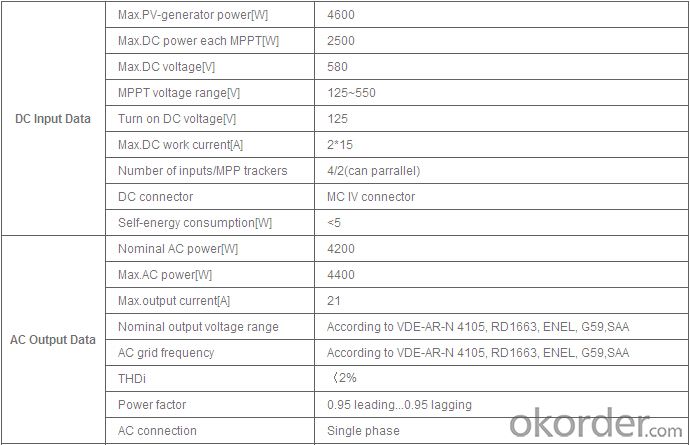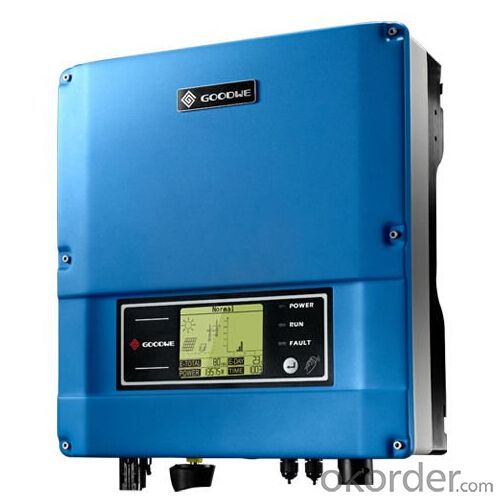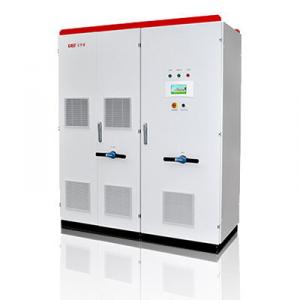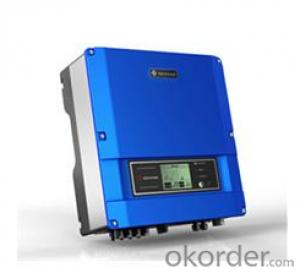Mpp Solar Inverter 12v On Grid Solar Inverter GW4200-DS
OKorder Service Pledge
OKorder Financial Service
You Might Also Like
GW4200-DS
GW4200-DS photovoltaic inverter is suitable for home rooftop photovoltaic system, designed under modern industrial concept.
There are three colors for option with fashionable appearance.
This model uses advanced digital control technology and communication method as well as super MPP tracking and security technology.
It has a wide range of input and output voltage.
To ensure its stability and long service life, our inverter is manufactured with optimum quality components.
It holds a safe lead among the same level of products.
Datasheet

- Q: What is the role of a solar inverter in maximizing solar panel output?
- The role of a solar inverter in maximizing solar panel output is to convert the direct current (DC) generated by the solar panels into alternating current (AC) which can be used to power electrical devices in homes or businesses. The inverter ensures that the AC output is synchronized with the grid's frequency and voltage, allowing for efficient and effective utilization of solar energy. Additionally, the inverter also helps in monitoring and optimizing the performance of the solar panels, ensuring that they operate at their maximum efficiency and produce the highest possible output.
- Q: Can a solar inverter be used in conjunction with a power factor correction device?
- Yes, a solar inverter can be used in conjunction with a power factor correction device. The power factor correction device is designed to improve the power factor of the electrical system and optimize the efficiency of energy usage. When connected to a solar inverter, it helps to correct the power factor of the solar power system, ensuring better utilization of the generated solar energy and reducing any potential power losses.
- Q: What is the maximum current output of a solar inverter?
- The maximum current output of a solar inverter depends on its size and specifications. In general, smaller residential inverters may have a maximum output current of around 8-12 amps, while larger commercial or utility-scale inverters can go up to several hundred amps. It is important to select an inverter that matches the specific requirements of the solar PV system to ensure optimal performance and safety.
- Q: How does a solar inverter synchronize with the grid frequency?
- A solar inverter synchronizes with the grid frequency by continuously monitoring the frequency of the electrical power supplied by the grid. It adjusts its own output frequency to match the grid frequency using a built-in control mechanism. This synchronization ensures that the solar inverter's power is in phase with the grid power, allowing it to smoothly inject electricity into the grid without causing disruptions or power quality issues.
- Q: Does a solar inverter require any additional cooling or ventilation?
- Yes, a solar inverter typically requires additional cooling or ventilation to maintain its optimal operating temperature and prevent overheating. This is because solar inverters convert DC power from solar panels into AC power, a process that generates heat. Adequate cooling or ventilation systems help dissipate this heat and ensure the inverter operates efficiently and reliably.
- Q: Can a solar inverter be used with a solar-powered water pump?
- Yes, a solar inverter can be used with a solar-powered water pump. The solar inverter converts the DC power generated by the solar panels into AC power, which is suitable for powering the water pump. This allows for efficient and reliable operation of the pump using solar energy.
- Q: What are the safety certifications for a solar inverter?
- Some common safety certifications for solar inverters include UL 1741, IEC 62109, and CSA C22.2 No. 107.1. These certifications ensure that the inverters meet specific safety standards and requirements, such as protection against electrical shock, fire hazards, and grid stability.
- Q: Can a solar inverter be used in areas with unstable grid connections?
- Yes, a solar inverter can be used in areas with unstable grid connections. Solar inverters are designed to convert the DC power generated by solar panels into AC power that can be used to power electrical devices or be fed back into the grid. In areas with unstable grid connections, a solar inverter can help stabilize the power supply by switching to off-grid mode when the grid connection is unstable or completely lost. This allows the solar system to continue generating and supplying power to the connected loads even during grid outages or fluctuations.
- Q: Can a solar inverter be used in systems with multiple inverters?
- Yes, a solar inverter can be used in systems with multiple inverters. In fact, using multiple inverters is a common practice in larger solar power systems. Each inverter is connected to a separate set of solar panels, and they work together to convert the DC power generated by the panels into AC power that can be used in homes or businesses. Multiple inverters allow for increased power output and better system efficiency.
- Q: Are there any limitations on the angle of the solar panels when using a solar inverter?
- Yes, there are limitations on the angle of the solar panels when using a solar inverter. The optimal angle for solar panels is typically determined based on the geographical location and the season. Deviating too much from the recommended angle can result in decreased energy production.
Send your message to us
Mpp Solar Inverter 12v On Grid Solar Inverter GW4200-DS
OKorder Service Pledge
OKorder Financial Service
Similar products
Hot products
Hot Searches
Related keywords



























